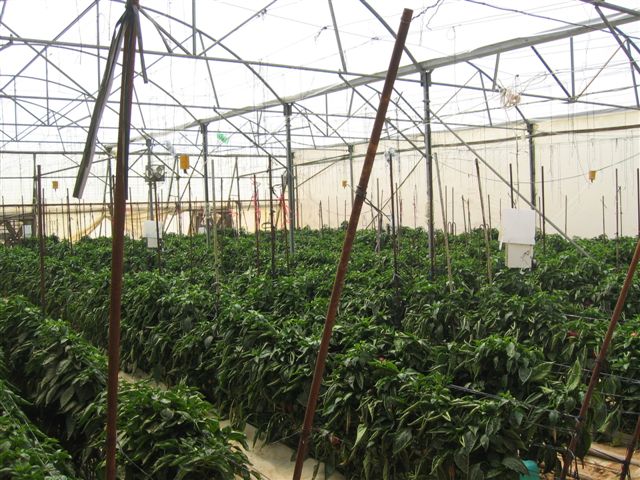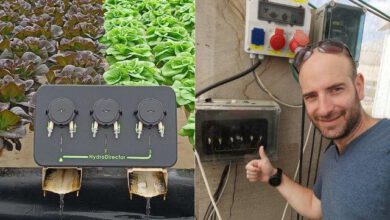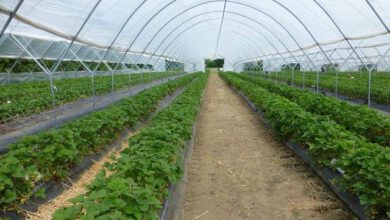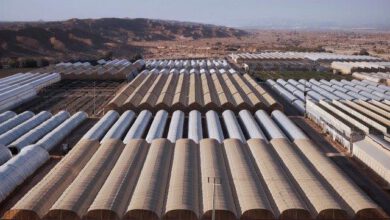Improved Greenhouse Ventilation and Control
The following describes new technical approaches that may contribute to better greenhouse operation
Dr. Meir Teitel

Greenhouses are designed to provide and maintain a desired environment that will affect plant growth and result in optimum crop production and maximum profit. Over the years, the greenhouse culture has become an industry of commercial plant production with a turnover of billions of dollars. This industry is continuously growing and seeking technological innovations. The following describes new technical approaches that may contribute to better greenhouse operation.
Improved forced ventilation
In warm climates, such as in Israel, ventilation is one of the most important actions in greenhouse cultivation. The primary purpose of ventilation is to prevent the excessive rise of temperature and humidity. This is achieved by replacing the hot and humid internal, greenhouse air with ambient cooler air that also lowers the excessive level of humidity caused by transpiration from the plant foliage and the ground. In some cases, it is applied to prevent CO2 depletion and keeps its concentration close to atmospheric level. Ventilation can also reduce the concentration of pollutant gases and is often used in heated greenhouses equipped with hot air furnaces within the enclosures. Ventilation also creates air movement near the leaves and thus reduces boundary layer resistance while allowing for higher transpiration and CO2 take up.
.jpg)
In Israel the fans are typically mounted on the sidewalls because of structure limitation and they provide a ventilation rate of 30-40 exchanges per hour. The ventilation fans are sized to deliver the required flow rate at 0.015 kPa static pressure when all guards and louvers are in place. The fans operate against higher static pressure when insect-proof screens are mounted on the openings. When ON-OFF control is used, the total rate of ventilation must be divided into increments due to economic reasons. The first stage should be 10- 25% of the total rate. For large structures, three or more stages are economical. A minimum velocity of 0.2 m/sec is recommended for preventing temperature, humidity or CO2 stratification.
Since large fans are often used in greenhouse ventilation to remove heat and reduce humidity, it was of interest to check the feasibility of applying variable frequency drives (VFD) to greenhouse fans in order to improve ventilation control and save energy. VFDs are routinely used to vary pump and fan speed in the heating, ventilating and air conditioning of buildings. In these applications, speed control is used to regulate the flow of water or air, as speed adjustment is an energy efficient method of flow control.
A comparison was conducted between ON-OFF and VFD systems to control greenhouse ventilation fans. The study was carried out in a semi- commercial greenhouse in which pepper was grown. The study was aimed to determine the effect of each system on the energy consumption and resulting greenhouse microclimate. To check the performance of the fan controlled by a VFD system, the unit was installed in a test facility and operated at several rotation speeds. At each speed of rotation, the static pressure on the fan was changed, and parameters such as electricity consumption and airflow rate were measured. Reducing the fan speed with the VFD system resulted in reductions in the airflow rate through the greenhouse and energy consumption, the latter being much more significant. The study showed that VFD control in greenhouses can reduce electricity consumption compared with ON-OFF operation by an amount which depends on the weather. In the present study, the average energy consumption with the VFD control system over a period of one month was about 0.64 of that with an ON-OFF system. The average greenhouse daily air temperatures and humidity ratios obtained with each control system between 0700 and 1800 were nearly equal during that month. The results obtained in the greenhouse further show that the VFD system has a greater potential than the ON-OFF, to reduce the range of amplitude variations in the air temperature and humidity ratio within the greenhouse.
Improved control of fan ventilated greenhouses
High radiation and vapor pressure deficit are quite common in Mediterranean greenhouses during the summer months. These conditions result in high transpiration rates, leading to greater water consumption of the crop. Therefore, measuring and modeling transpiration can be a useful tool for efficient irrigation management by allowing for the prediction of short term water demand. In addition to the prediction of transpiration, developing tools for the accurate estimation of photosynthesis values can be useful for several purposes (e.g. estimation of plant production, examination of profitability of carbon enrichment in greenhouses and improving climate control). The present study examined the possibility of estimating instantaneous average crop transpiration and photosynthesis by using the open chamber approach. Such an approach can be utilized in a greenhouse that is ventilated by fans. The rate of transpiration and photosynthesis of Capsicum annuum var. Selica was measured during the Spring and Summer of 2007 in a greenhouse located in the Besor experimental station (in southern Israel) that was ventilated by fans. The rate of transpiration was measured by six lysimeters, each measuring the transpiration of two plants. It was also calculated by multiplying the difference in the humidity ratio between greenhouse air outlet and inlet, by the air flow rate through the greenhouse. Photosynthesis was measured on a few plants by using the gas exchange measuring system LI-6200 (Li Cor) and was also estimated by multiplying the difference in the CO2 concentration between air outlet and inlet by the air flow rate through the greenhouse. Results show a good accord between the two methods used for estimating transpiration and also between the two methods used for estimating photosynthesis. The average daily transpiration levels measured by the open chamber approach and by the lysimeters were 263±32 and 273±38 Wm-2, respectively (where ± denotes 95% confidence interval). Photosynthesis at midday was measured at 8.1±1.3 and 10.3±1.6 mmole m-2 s-1 with both the open chamber approach and the LI-6200 analyzer. The results suggest that the average crop transpiration and photosynthesis can be estimated with fair accuracy from measurements of water vapor content and CO2 concentration of the air at the inlet and outlet of a greenhouse ventilated by fans. The data also shows that the open chamber approach responds very quickly to instantaneous changes in solar radiation that influence both photosynthesis and transpiration. In the future, it may be possible to combine the open chamber approach with the VFD in a feedback control system that will change the speed of the fans according to the rate of crop photosynthesis so that the highest rates of photosynthesis are maintained during the day.

Acknowledgements:
The author thanks Dr. A. Schwartz, Dr. S. Cohen, Mr. M. Atias, Mr. M. Barak, Mr. A. Levi, Mr. Y. Zhao, Mr. E. Bar-lev, Mr. David Shmuel and Mr. G. Lidor for their contribution during the course of the projects.
Author:
Dr. Meir Teitel, Institute of Agricultural Engineering, grteitel@agri.gov.il
Agricultural Research Organization, The Volcani Center, P.O. Box 6, Bet Dagan 50250, Israel
(Published in ISRAEL AGRICULTURE, 2009)




